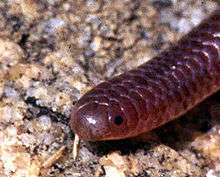Leptotyphlopidae
| Leptotyphlopidae | |
|---|---|
 | |
| Western blind snake, Leptotyphlops humilis | |
| Scientific classification | |
| Kingdom: | Animalia |
| Phylum: | Chordata |
| Subphylum: | Vertebrata |
| Class: | Reptilia |
| Order: | Squamata |
| Suborder: | Serpentes |
| Infraorder: | Scolecophidia |
| Family: | Leptotyphlopidae Stejneger, 1892 |
| Subfamilies | |
|
Epictinae | |
| Synonyms | |
| |
The Leptotyphlopidae (commonly called slender blind snakes or thread snakes[2]) are a family of snakes found in North and South America, Africa, and Asia. All are fossorial and adapted to burrowing, feeding on ants and termites. Two genera are recognized comprising 87 species.[2]
Description
These relatively small snakes rarely exceed 30 cm in length; only Leptotyphlops macrolepis and L. occidentalis grow larger. The cranium and upper jaws are immobile and no teeth are in the upper jaw. The lower jaw consists of a much elongated quadrate bone, a tiny compound bone, and a relatively larger dentary bone.[3] The body is cylindrical with a blunt head and a short tail. The scales are highly polished. The pheremones they produce protect them from attack by termites.[4] Among these snakes is what is believed to be the world's smallest: L. carlae (Hedges, 2008).[5]
Geographic range
These snakes are found in Africa, western Asia from Turkey to eastern India, on Socotra Island, and from the southwestern United States south through Mexico and Central America to South America, though not in the high Andes. In Pacific South America, they occur as far south as southern coastal Peru, and on the Atlantic side as far as Uruguay and Argentina. In the Caribbean, they are found on the Bahamas, Hispaniola, and the Lesser Antilles.[1]
Habitat
They occur in a wide variety of habitats from arid areas to rainforest, and are known to occur near ant and termite nests.
Feeding
Their diets consist mostly of termite or ant larvae, pupae, and adults. Most species suck out the contents of insect bodies and discard the exoskeleton.
Reproduction
Snakes in this family are oviparous.[3]
Genera
| Genus[2] | Taxon author[2] | Species[2] | Common name | Geographic range[1] |
|---|---|---|---|---|
| LeptotyphlopsT | Fitzinger, 1843 | 86 | Slender blind snakes, thread snakes[2] | Africa, southwestern Asia, on Socotra Island, from the southwestern United States south through Mexico, Central America and South America as far as Uruguay and Argentina. In the Caribbean they are found on the Bahamas (San Salvador Island), the Dominican Republic, Haiti, Hispaniola and the Lesser Antilles. |
| Rhinoleptus | Orejas-Miranda, Roux-Estève and Guibé, 1970 | 1 | Villiers' blind snake[3] | West Africa: Senegal and Guinea. |
See also
| Wikispecies has information related to: Leptotyphlopidae |
| Wikimedia Commons has media related to Leptotyphlopidae. |
- List of leptotyphlopid species and subspecies
- Leptotyphlopidae by common name
- Leptotyphlopidae by taxonomic synonyms
- List of snakes, overview of all snake genera
References
- 1 2 3 4 McDiarmid RW, Campbell JA, Touré T. 1999. Snake Species of the World: A Taxonomic and Geographic Reference, vol. 1. Herpetologists' League. 511 pp. ISBN 1-893777-00-6 (series). ISBN 1-893777-01-4 (volume).
- 1 2 3 4 5 6 "Leptotyphlopidae". Integrated Taxonomic Information System. Retrieved 18 August 2007.
- 1 2 3 Leptotyphlopidae at the Reptarium.cz Reptile Database. Accessed 3 November 2008.
- ↑ Field Guide to Snakes of Southern Africa - Bill Branch (Struik 1988)
- ↑ Hedges SB. 2008. At the lower size limit in snakes: two new species of threadsnakes (Squamata, Leptotyphlopidae, Leptotyphlops) from the Lesser Antilles. Zootaxa 1841:1-30.PDF at Zootaxa. Accessed 28 July 2008.